Learn how to make a sourdough starter recipe from scratch with just flour and water. This versatile ingredient can be used to make breads, cakes, cookies, and so much more.
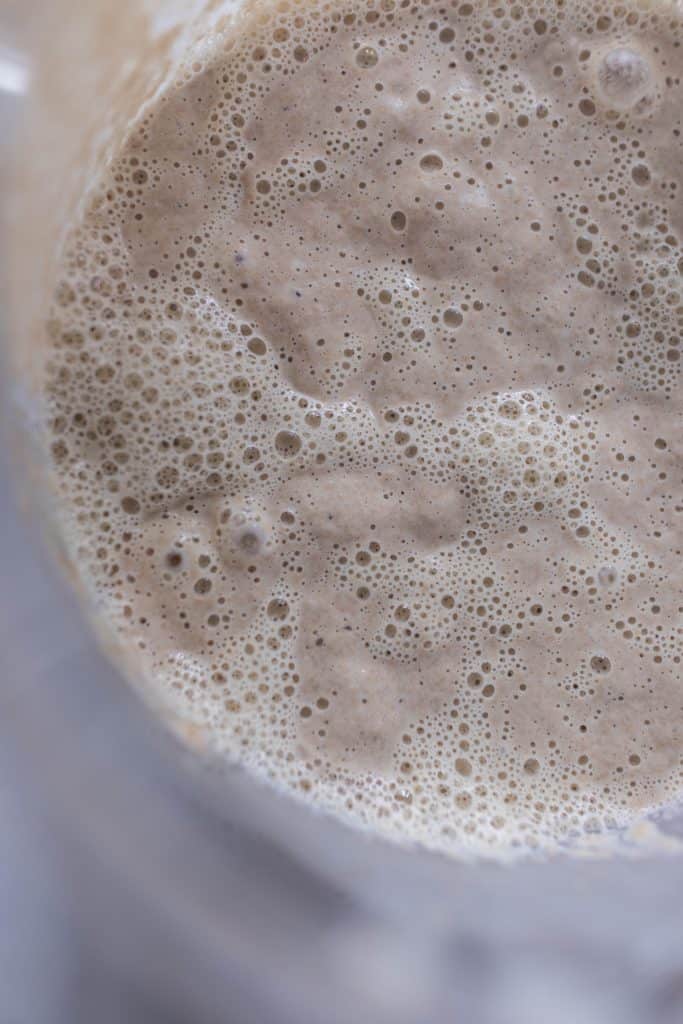
If you hang around the traditional foods community, chances are you have heard of making homemade sourdough starter from scratch.
I have had my homemade starter for over six years now. It is vital in my traditional food kitchen.
What Is A Sourdough Starter?
A sourdough starter is a live active culture made of fermented flour and water that is full of beneficial bacteria and yeasts.
It is used as a way to ferment recipes and naturally rise bread.
Why You Will Love Sourdough:
If you are unfamiliar, let me fill you in on all the reasons why crazy folks, like me, go through the effort of handcrafting, and maintaining, a beneficial colony of yeasts and bacteria in their kitchens.
Before yeast was isolated and sold in little packets, sourdough starter was a valuable commodity in homes and families, passed down for generations.
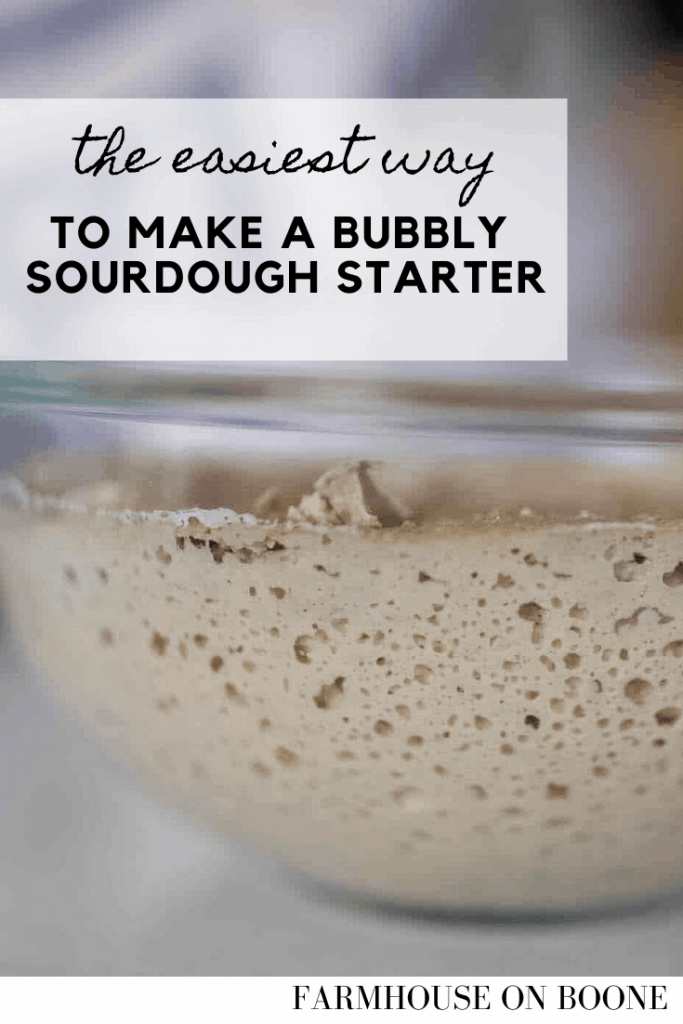
Health Benefits
Have you ever heard of phytic acid? Basically, it’s an antinutrient found in grains, beans, and nuts that interferes with the absorption of certain nutrients. They are present on grains to keep them from spoiling.
There is a reason they are there, but there is also good evidence that our bodies weren’t meant to handle them. Proper preparation of grains eliminates most, if not all, of the phytic acid in offending foods.
This is the very reason traditional cultures soaked and fermented their grains, seeds, and beans. These days, we’ve lost that art. And what have we found? People can’t handle grains anymore.
Instead of using instant yeast packets, people in traditional cultures leavened their bread with a fermented starter that captured all the yeasts in the environment.
AKA Sourdough starter
How on earth do we capture native yeasts? Read on, because I explain how to make your very own starter.
Because I love good food
I already confessed my foodie tendencies with you all. I reckon it’s the same inclination that led me into the world of homemade sourdough.
Locally made sourdough starter, with the native yeasts of the area present, is certainly the thing a foodie’s dreams are made of. A jar of healthy, productive starter is teaming with life, as evidenced by all the bubbles you will see rising to the surface.
Once you’ve experienced homemade sourdough baked goods, store-bought breads and pancakes simply don’t cut it. Sourdough has a depth of flavor that just can’t be found in something made quickly with a packet of instant yeast.
This post contains affiliate links, which means I make a small commission at no extra cost to you. See my full disclosure here.
FAQ:
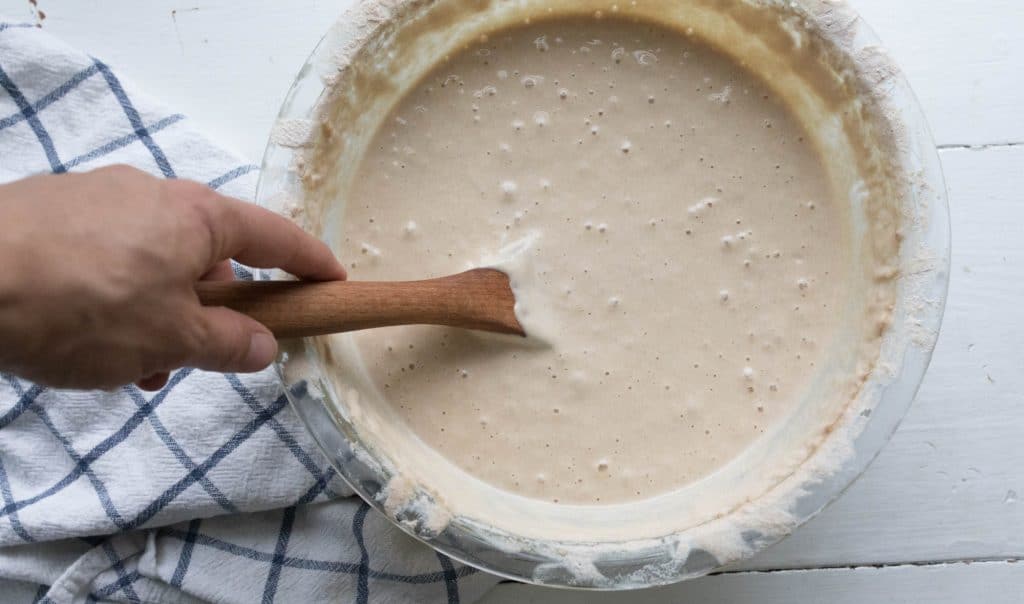
How long does it take to make sourdough starter?
It takes about a week to create an active sourdough starter, but sometimes it can take about two weeks to make a starter ready to bake bread.
Do you have to discard sourdough starter every time you feed it?
When you are first creating your sourdough starter, yes. If you don’t discard you will have so much starter that it will be hard to keep healthy. This is because the more starter you have the more flour and water you will need to add for the yeasts and bacteria to feed on.
After having a starter for a while rather than discarding you can just use it in discard recipes. This is a much more useful way of removing some of the starter rather than throwing it in the trash.
How do you know your sourdough starter is ready to use?
You will know your sourdough starter is read to use when you feed it and after 4-12 hours it doubles in size and is super bubbly. A good way to be able to determine this, is to place a rubber band where the top of the starter is after you feed it. Then after a few hours have passed you can see just how high it has grown.
Another way is to perform the float test. Take a small glass of room temperature water. Add a quarter sized dollop of active starter. If it floats, it is ready to bake with. If it doesn’t it is not active enough.
Sourdough Starter Recipe:
By now, you know why you want to have a bowl of sourdough starter bubbling away in your kitchen, but how the heck do you make one?
Ingredients
Flour (Whole grain wheat, unbleached all-purpose, and einkorn are all great choices.)
Filtered water (I use a Berkey water filter. We have the Royal size for our family of 7. You can find my full Berkey review HERE.)
Tools
Glass bowl (Metal can react with beneficial bacteria and yeasts.)
Tea towel
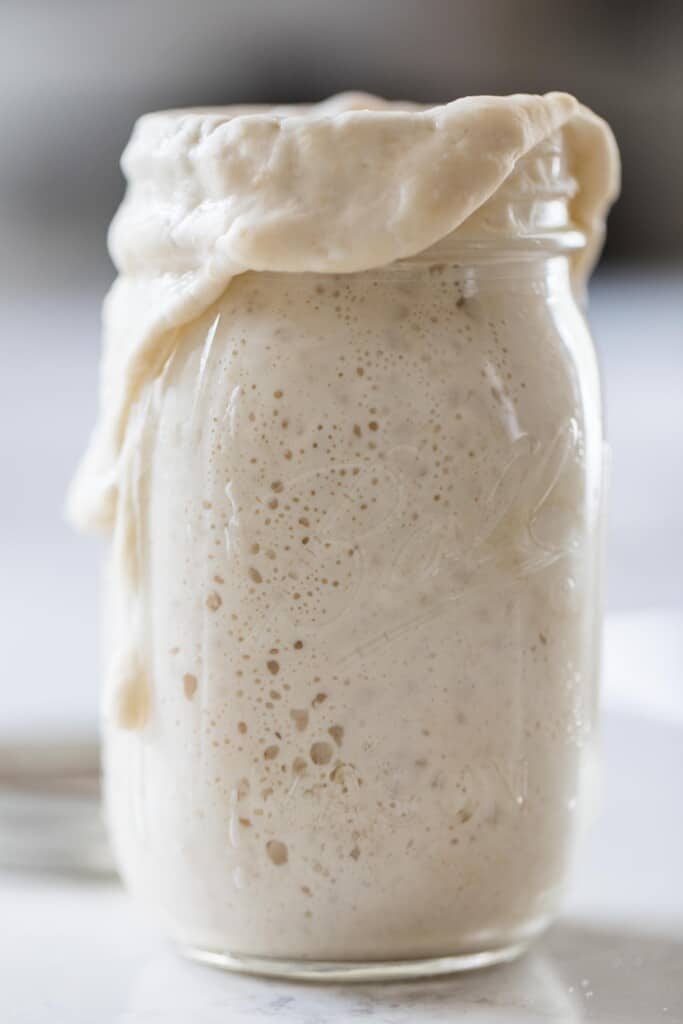
How To Make Sourdough Starter
Day 1:
On day one, mix one cup of flour and one cup filtered water. Stir vigorously, making sure to scrape down the sides and incorporate everything. Place a clean tea towel over the bowl and set aside. Allow it to sit for 24 hours.
Day 2:
On day two, discard half of the mixture and repeat the process. Add one cup flour, one cup water, stir vigorously, and cover.
Why do you have to remove half the mixture? By day four, you would have sourdough starter overflowing from your bowl. Also, removing half ensures that the right amount of flour and water is feeding the growing colony of beneficial yeast. If you weren’t discarding half, the cup of flour wouldn’t be enough to feed them on days three and four. Basically, you would end up with a lot of extra starter by the end of the process, and none of it would be mature.
Day 3-5
Repeat the day two instructions for days three, four, and five.
Day 6-7
On days six and seven, do the same but feed it every 12 hours, instead of every 24.
By day seven, there should be enough beneficial bacteria and yeast present to bake sourdough bread and other fermented sourdough goodies, like pancakes and english muffins.
You will know it’s working if it bubbles, and doubles in size.
Sourdough Starter Maintenance
Once your sourdough starter is alive and active, there will be some maintenance to keep it going for years and years.
In the refrigerator for occasional use
Storing it in the refrigerator slows down the fermentation process, so one feeding per week, or every other week, is sufficient.
I usually use my starter a couple times per week. If I plan to make pancakes Saturday morning, for example, I will pull my starter out of the fridge Friday morning and add flour and water. By Saturday morning it is bubbly and ready to go.
I remove the two cups of starter needed for my pancake recipe, and put the “master starter” back in the fridge. Since it was fed the day before, it is good to go for another week, or whenever I need it next.
On the counter for daily use
Since the “little guys”, as my kids like to call the bacteria in the starter, are active at room temperature, they will have to be fed more often if keep it in this state.
If you leave your starter out on the counter, you will need to add flour and water every day. You will also have to be baking every day to use up all that starter.
Most people probably won’t use the starter quite so much, unless you own and operate a bakery. I would recommend storing it in the refrigerator between uses.
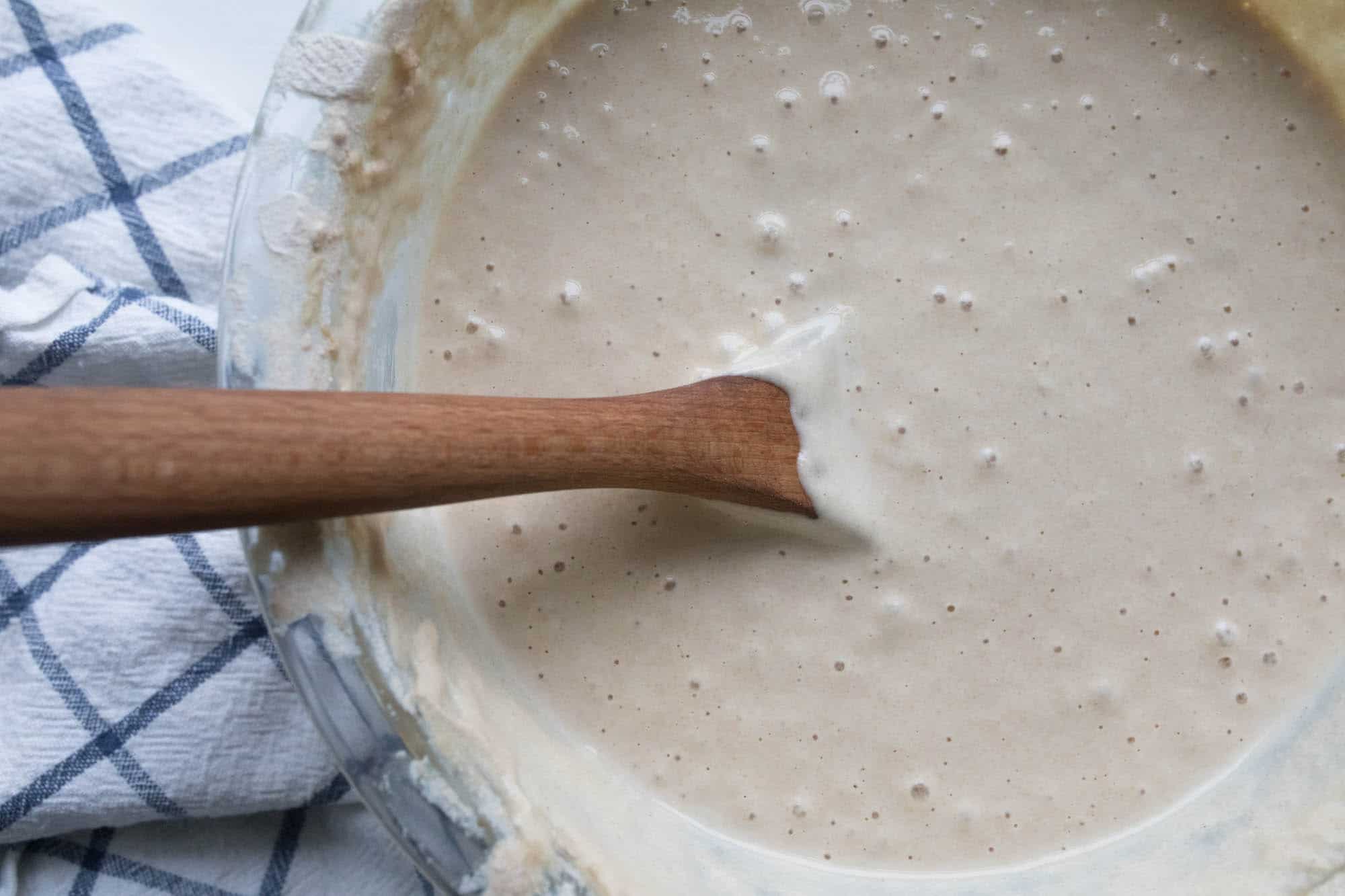
Helpful Resources
Every day I get loads of questions about sourdough starter, so I devoted a whole post called, How to Care for Sourdough Starter filled with your questions and my answers. You can use this post a reference guide.
Thank you so much for stopping by the farmhouse! I hope this is just the beginning of our sourdough journey.
Check out my other sourdough recipes and posts
- Sourdough English Muffins
- Sourdough Pizza Crust
- Healthy One Pot Meal- Sourdough Skillet
- Sourdough Tortillas
- Easy Sourdough Focaccia
- Dry Sourdough Starter
If you try this recipe and love it, I would love if you gave it 5 stars! Also, tag me on Instagram @farmhouseonboone.
Sourdough Starter
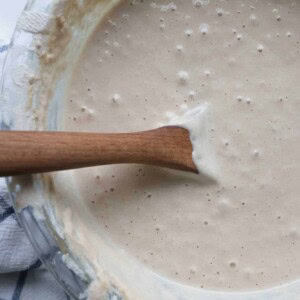
Ingredients
- Flour, Whole grain wheat, unbleached all purpose, and einkorn are all great choices.
- Filtered water
Instructions
- On day one, mix one cup of flour and one cup filtered water. Stir vigorously, making sure to scrape down the sides and incorporate everything. Place a clean tea towel over the bowl and set aside. Allow it to sit for 24 hours.
- On day two, discard half of the mixture and repeat the process. Add one cup flour, one cup water, stir vigorously, and cover.
- Repeat the day two instructions for days three, four, and five.
- On days six and seven, do the same but feed it every 12 hours, instead of every 24.
- By day seven, there should be enough beneficial bacteria and yeast present to bake sourdough bread and other fermented sourdough goodies, like pancakes and english muffins. You will know it’s working if it bubbles, and doubles in size.
Notes
Sourdough Starter Maintenance
- Once your sourdough starter is alive and active, there will be some maintenance to keep it going for years and years.
In The Refrigerator For Occasional Use
- Storing it in the refrigerator slows down the fermentation process, so one feeding every week, or every other week, is sufficient.
- I usually use my starter a couple times per week. If I plan to make pancakes Saturday morning, for example, I pull my starter out of the fridge Friday morning and add flour and water. By Saturday morning it is bubbly and ready to go. I remove the two cups of starter needed for my pancake recipe and put the “master starter” back in the fridge. Since it was fed the day before, it is good to go for another week, or whenever I need it next.
On The Counter For Daily Use
- Since the “little guys”, as my kids like to call the bacteria in the starter, are active at room temperature, they will have to be fed more often if kept in this state.
- If you leave your starter out on the counter, you will need to add flour and water every day. You will also have to be baking daily to use up all that starter.
- Most people probably won’t use the starter quite so much, unless you own and operate a bakery. I would recommend storing it in the refrigerator between uses.
Nutrition information is automatically calculated, so should only be used as an approximation.
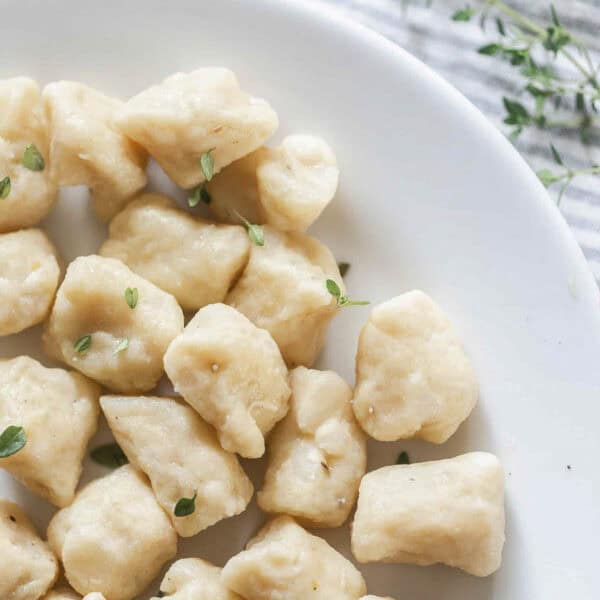
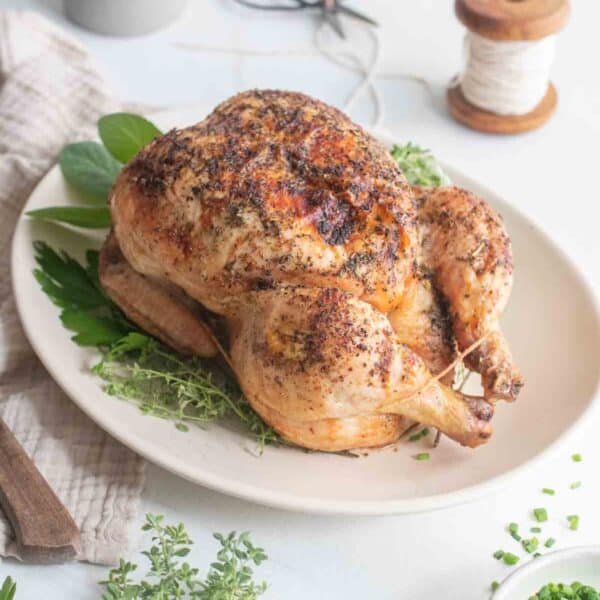
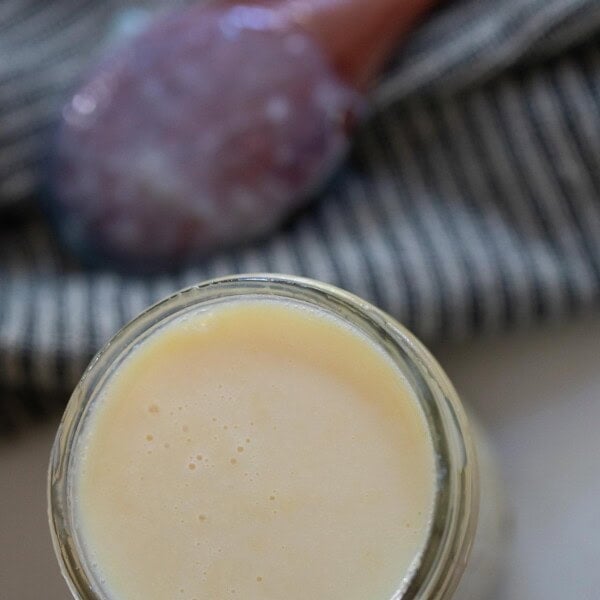
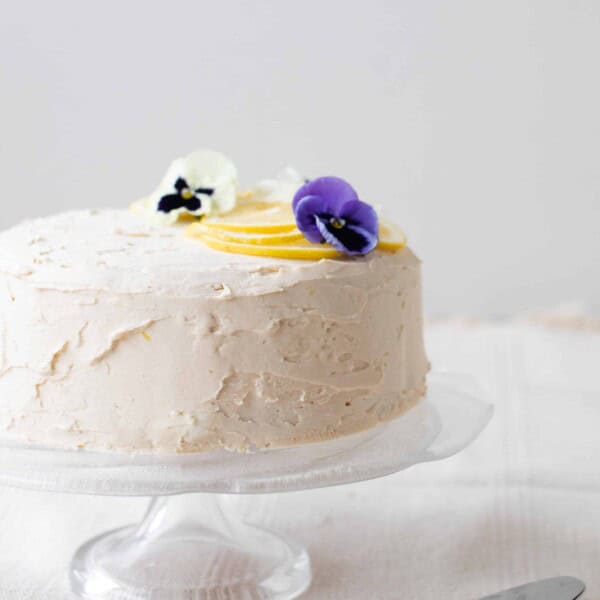






I just made the starter; and, after doing it every twelve hours for a couple of days, I did see bubbles, but not necessarily much of a rise. Should I just do the 24 hours again, and not repeat the twelve hours? Our house is at 66-67 at night and warmer during the day.
I also made the pancakes; but, they didn’t fluff up a whole lot. Is that normal?
One more question: Do I continue to discard every time I feed it, once it’s been started for a week?
I would try putting it somewhere a bit warmer! Bubbles are a great sign, but I bet if you have it in a warmer spot it will start to rise. I would also cut back to 24 hour feedings just to see if your starter needs more time to rise.
Once it is established, discarding isn’t necessary unless you have too much starter that is not active and you need to feed it before using it in a recipe.
Hi! I have purchased your book and look forward to trying many of your recipes once I get an active starter. I am on day ten (my fourth day of feeding every 12 hours). I am seeing bubbles but no increase in size at all. Every time before I feed, a considerable amount of clear-ish liquid is on the top. I stir my starter before removing the discard and feeding, using King Arthur All Purpose unbleached flour and bottled water. I warm the water to lukewarm by setting it in a cup of hot water before adding. My kitchen is consistently at 68 degrees this time of year. Does my starter have hope, or do I need to start over? I would appreciate any advice or encouragement you could give. Thank you from a fellow Missourian. 🙂
I would try adding 1 cup of flour to 3/4 cup of water and see if that helps your starter become active!
Also have been unable to produce a healthy starter with this recipe… not sure what is going wrong but it’s so frustrating and wasteful!
I am sorry you are having struggles. Are you using filtered water? Unbleached all purpose flour? Keeping it warm enough? If yes to all, then I would try using 1 cup of flour to 3/4 cup water.
I am on Day 4 of trying to make my own starter! It smells terrible! This is normal I assume? Once it starts bubbling and doubling (hopefully in the next week!) what do you do then? Begin a discard jar with half of the starter? If you discard half like I’ve been doing you’re left with about a cup of starter…when I feed it I would do 1/2 c water and 1/2 c flour correct?
You are on the right track! Just keep feeding and discarding until it is ready. You can collect the discard and use it in any discard recipe.
Hi, I am on day eight. Today is my third day feeding every 12 hours. I am seeing bubbles but no increase in size at all yet. Every time before I feed, a considerable amount of clear-ish liquid is on the top. I mix in the liquid before removing the discard and feeding. Does my starter have hope, or do I need to start over? Thank you for your help!
If you are still seeing lots of liquid, I would try adding a bit more flour than water. So up the ratio to 1 cup flour 3/4 cup water.
I ordered the book and have had my starter for over a week now and it’s bubbly and smells sour but it isn’t doubling… what do I need to do
Tried this recipe and didn’t work out. After a quick google into why, it’s obvious 1cup of water to 1 cup of flour daily is double the amount of water needed. All other sources advise 1/2 cup of water to 1 cup flour. Followed a recipe advising these ratios and it worked perfect. I wonder if the author has even tried this recipe herself.
Doesn’t that ratio just result in dry dough?
I expected a sourdough starter, but all I got was disappointment. Still not matured after three weeks, causing a waste of flour and water. I think something is wrong with this recipe because I followed it to a T.
Can you tell me what your starter looked like? Were you using filtered water and AP flour? Did it ever develop bubbles or rise? I would like to help you get your starter active and bubbly!
Smooth but still fairly thick. I used unbleached, all-purpose flour and filtered (bottled) water. I got rid of it but want to try again.
It was smooth but pretty thick. It developed a lot of bubbles on night one into the morning but didn’t do a ton after that. I used King Arthur unbleached all-purpose flour and filtered (bottled) water. I got rid of it but want to try again.
No reply after a week? You must really want to “help me get my starter active and bubbly!” LOL.
I am sorry! I must have missed your comment.
You were replying to someone else’s comment about dry dough from the ratio 1/2 cup water to 1 cup flour. I recommend 1 cup water to 1 cup flour for a 1:1:1 ratio. If people are having trouble and seeing quite a bit of hooch, despite feeding, then I recommend 3/4 cup water to 1 cup flour.
Hope this helps.
I have an active starter now. What helped was looking at another recipe and seeing that I need to do two parts flour to one part water. Ignoring your “advice” was the best thing I did, and I hope that you will take that to heart and modify your recipe so that it works. That’s why the comments are full of people calling you out, fraud.
Do you continue to get ride of half and adding the one cup of water and one cup of flour on day six and seven or just add the one cup of water and one cup of flour
Yes continue to get rid of half, even when you are feeding every 12 hours.
First time I ever saw you I literally fell in love with you it was on Facebook videos and ever since then I have been easily watching and anticipating all your videos you make everything seem so simple and so easy that doing things from scratch and homemade doesn’t really take him much more time or effort then all the different convenience things that are out there